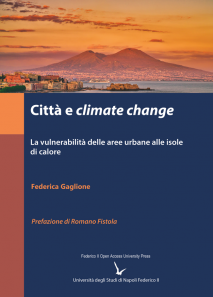Città e climate change. La vulnerabilità delle aree urbane alle isole di calore
Keywords:
Cambiamento climatico, isole di calore, vulnerabilità urbana, analisi spazialiSinossi
Editore: FedOA Press - Federico II Open Access University Press
Collana: Smart City, Urban Planning for a Sustainable Future
Pagine: 135
Lingua: Italiano
NBN: http://nbn.depositolegale.it/resolver.pl?nbn=urn:nbn:it:unina-28254
Abstract: Il cambiamento climatico rappresenta una delle principali minacce a cui il nostro pianeta è chiamato a dare risposte, sia in termini di mitigazione dei fenomeni che di adattamento agli impatti sull’ambiente costruito. L’’International Panel for Climate Change (IPCC), nei suoi ultimi report evidenzia come i fenomeni legati alla variabilità climatica si andranno intensificando nei prossimi decenni e gli eventi estremi connessi al clima costituiranno un rischio crescente, in particolare per le nostre città. In tale direzione, il lavoro di ricerca affrontato all’interno di questo volume mira a dare un contributo alla ricerca scientifica sul tema della vulnerabilità delle aree urbane alle isole di calore. Nel dettaglio, il volume si articola in quattro capitoli. Nei primi due si illustra lo stato dell’arte, mettendo a punto un esauriente quadro conoscitivo di questa tematica. Sono evidenziati i differenti approcci e i diversi modelli anche attraverso la lettura dei piani di adattamento europei ed italiani. Si prendono in esame le strategie, le azioni e gli interventi proposti per migliorare l’assetto e l’organizzazione del territorio. Il terzo capitolo propone una metodologia volta al rilevamento delle temperature con l’utilizzo di metodi di analisi spaziale in ambiente GIS in relazione alle caratteristiche urbane, utile a misurare la vulnerabilità dei sistemi urbani alle isole di calore, in accordo con le teorie e i modelli emanati dall’ IPCC. Infine, nel quarto capitolo, si riporta una prima sperimentazione sulla città di Napoli dei risultati del lavoro di ricerca, definendo le porzioni di territorio della V e VIII municipalità dove è necessario intervenire con priorità, come primo passo per la messa a punto di uno strumento di supporto alle decisioni per le pubbliche amministrazioni.
Downloads
Riferimenti bibliografici
Akbari, H., & Konopacki, S. (2005). Calculating energy-saving potentials of heat-island reduction strategies. Energy policy, 33(6), 721-756. https://doi.org/10.1016/j.enpol.2003.10.001
An, E. U. (2013). Strategy on adaptation to climate change. Communication from the Commission to the European Parliament, the Council, the European Economic and Social Committee and the Committee of the Regions, COM, 216.
Anderson, K., & Bows, A. (2008). Reframing the climate change challenge in light of post-2000 emissions trends. Philosophical Transactions of the Royal Society, 366, 3863–3882. https://doi.org/10.1098/rsta.2008.0138
Arifwidodo, S., & Chandrasiri, O. (2015). Urban heat island and household energy consumption in Bangkok, Thailand. Energy Procedia, 79, 189-194. https://doi.org/10.1016/j.egypro.2015.11.461
Aubrecht, C., Özceylan, D., Steinnocher, K., & Freire, S. (2013). Multi-level geospatial modeling of human exposure patterns and vulnerability indicators. Natural Hazards, 68(1), 147-163. https://doi.org/10.1016/j.envint.2013.03.005
Bai, X., Dawson, R. J., Ürge-Vorsatz, D., Delgado, G. C., Barau, A. S., Dhakal, S., ... & Roberts, D. (2018). Six research priorities for cities and climate change. Nature, 555(7694), 23-25. Retrieved from https://www.nature.com/magazine-assets/d41586-018-02409-z/d41586-018-02409-z.pdf (Last Access 29th August 2018)
Balaganesh, G., Malhotra, R., Sendhil, R., Sirohi, S., Maiti, S., Ponnusamy, K., & Sharma, A. K. (2020). Development of composite vulnerability index and district level mapping of climate change induced drought in Tamil Nadu, India. Ecological Indicators, 113, 106197. https://doi.org/10.1016/j.ecolind.2020.106197
Bao, J., Li, X., & Yu, C. (2015). The construction and validation of the heat vulnerability index, a review. International journal of environmental research and public health, 12(7), 7220-7234. https://doi.org/10.3390/ijerph120707220
Bhattacharjee, S., Gerasimova, E., Imbert, C., Tencar, J., & Rotondo, F. (2019, June). Assessment of Different Methodologies for Mapping Urban Heat Vulnerability for Milan, Italy. In IOP Conference Series: Earth and Environmental Science (Vol. 290, No. 1, p. 012162). IOP Publishing. 10.1088/1755-1315/290/1/012162
Biesbroek, G. R., Swart, R. J., & Van der Knaap, W. G. (2009). The mitigation–adaptation dichotomy and the role of spatial planning. Habitat international, 33(3), 230-237. https://doi.org/10.1016/j.habitatint.2008.10.001
Block, A. H., Livesley, S. J., & Williams, N. S. (2012). Responding to the urban heat island: a review of the potential of green infrastructure. Victorian centre forclimate change Adaptation research Melbourne. ISBN:9780734048134
C. Riegel, A. Trum, C. Maximini, D. Vallée Klimaschutzteilkonzept "Anpassung an den Klimawandel für die Städte Solingen und Remscheid (2013). Retrivied from: http://www.bergischesdreieck.de/fileadmin/user_upload/wirtschaftsregion/PDFs/Regionales_Klimaschutzteilkonzept_Klimawandel.pdf.pdf
C. Rosenzweig, W.D. Solecki, S.A. Hammer, S. Mehrohtra (Eds.), Climate change and cities first assessment report of the urban climate change research.
Cancila, E., & Iraldo, F. (2011). Strategie per il clima: dalle regioni alle città. Linee guida per lo sviluppo di politiche e azioni di riduzione dei gas serra nel governo del territorio. Franco Angeli Editore. ISBN: 9788856845464
Carter, J. G., Cavan, G., Connelly, A., Guy, S., Handley, J., & Kazmierczak, A. (2015). Climate change and the city: Building capacity for urban adaptation. Progress in planning, 95, 1-66. https://doi.org/10.1016/j.progress.2013.08.001
Chapman, S., Watson, J. E., Salazar, A., Thatcher, M., & McAlpine, C. A. (2017). The impact of urbanization and climate change on urban temperatures: a systematic review. Landscape Ecology, 32(10), 1921-1935. https://doi.org/10.1007/s10980-017-0561-4
Chelleri, L., Favaro, A., Lucchitta, B., Raventos, J., & Fernandez, M. (2013). Dall’adattamento urbano al cambiamento climatico alla resilienza urbana: il caso di Barcellona, Spagna. In Proceedings of the National Conference “Il clima cambia le città”, Venice, May (pp. 23-24)
Chen, F., Yang, X., & Zhu, W. (2014). WRF simulations of urban heat island under hot-weather synoptic conditions: The case study of Hangzhou City, China. Atmospheric research, 138, 364-377. https://doi.org/10.1016/j.atmosres.2013.12.005
Chiesa, G., & Palme, M. (2018). Valutare la vulnerabilità urbana ai cambiamenti climatici e alle isole di calore urbano. TECHNE: Journal of Technology for Architecture & Environment, 15.
Chow, W. T., Chuang, W. C., & Gober, P. (2012). Vulnerability to extreme heat in metropolitan Phoenix: spatial, temporal, and demographic dimensions. The Professional Geographer, 64(2), 286-302. https://doi.org/10.1080/00330124.2011.600225
Conticelli, E., & Tondelli, S. (2018). Regenerating with the green: a proposal for the coastal landscape of Senigallia. TRIA-Territorio della Ricerca su Insediamenti e Ambiente, 11(1), 91-104. DOI 10.6092/2281-4574/5820
Cui, Y., Yan, D., Hong, T., & Ma, J. (2017). Temporal and spatial characteristics of the urban heat island in Beijing and the impact on building design and energy performance. Energy, 130, 286-297. https://doi.org/10.1016/j.energy.2017.04.053
Da Silva J., Kernaghan S., Luque A. (2012). A systems approach to meeting the challenges of urban climate change. International Journal of Urban Sustainable Development, 4(2), 125–145.
De Carolis, L. (2012). The urban heat island effect in Windsor, ON: an assessment of vulnerability and mitigation strategies. City of Windsor.
Dhalluin, A., & Bozonnet, E. (2015). Urban heat islands and sensitive building design–A study in some French cities’ context. Sustainable Cities and Society, 19, 292-299. https://doi.org/10.1016/j.scs.2015.06.009
Dienst, M., Lindén, J., Saladié, Ò., & Esper, J. (2019). Detection and elimination of UHI effects in long temperature records from villages–A case study from Tivissa, Spain. Urban Climate, 27, 372-383. https://doi.org/10.1016/j.uclim.2018.12.012
Dodman, D., Bicknell, J., & Satterthwaite, D. (Eds.). (2012). Adapting cities to climate change: understanding and addressing the development challenges. Routledge.
Dong, J., Lin, M., Zuo, J., Lin, T., Liu, J., Sun, C., & Luo, J. (2020). Quantitative study on the cooling effect of green roofs in a high-density urban Area—A case study of Xiamen, China. Journal of Cleaner Production, 255, 120152. https://doi.org/10.1016/j.jclepro.2020.120152
Eakin, H., & Bojórquez-Tapia, L. A. (2008). Insights into the composition of household vulnerability from multicriteria decision analysis. Global Environmental Change, 18(1), 112-127. https://doi.org/10.1016/j.gloenvcha.2007.09.001
Ebi, K. L., Kovats, R. S., & Menne, B. (2006). An approach for assessing human health vulnerability and public health interventions to adapt to climate change. Environmental health perspectives, 114(12), 1930-1934. https://doi.org/10.1289/ehp.8430
Emilsson, T., & Sang, Å. O. (2017). Impacts of climate change on urban areas and nature-based solutions for adaptation. In Nature-Based Solutions to Climate Change Adaptation in Urban Areas (pp. 15-27). Springer, Cham.
Estrada, F., Botzen, W. W., & Tol, R. S. (2017). A global economic assessment of city policies to reduce climate change impacts. Nature Climate Change, 7(6), 403-406. https://doi.org/10.1038/nclimate3301
European Commission (2013b). Commission Staff Working Document. Climate change adaptation, coastal and marineissues (SWD(2013) 133 final). https://ec.europa.eu/clima/sites/clima/files/adaptation/what/docs/swd_2013_133_en.pdf (Last Access15th October 2018)
Evola, G., Gagliano, A., Fichera, A., Marletta, L., Martinico, F., Nocera, F., & Pagano, A. (2017). UHI effects and strategies to improve outdoor thermal comfort in dense and old neighbourhoods. Energy Procedia, 134, 692-701. https://doi.org/10.1016/j.egypro.2017.09.589
Füssel, H. M., & Klein, R. J. (2006). Climate change vulnerability assessments: an evolution of conceptual thinking. Climatic change, 75(3), 301-329. https://doi.org/10.1007/s10584-006-0329-3
Gago, E. J., Roldan, J., Pacheco-Torres, R., & Ordóñez, J. (2013). The city and urban heat islands: A review of strategies to mitigate adverse effects. Renewable and Sustainable Energy Reviews, 25, 749-758. https://doi.org/10.1016/j.rser.2013.05.057
Gartland, L. (2008), Heat Islands. Understanding and Mitigating Heat in Urban Areas. London: Earthscan
Giridharan, R., & Kolokotroni, M. (2009). Urban heat island characteristics in London during winter. Solar Energy, 83(9), 1668-1682. https://doi.org/10.1016/j.solener.2009.06.007
Grafakos, S., Viero, G., Reckien, D., Trigg, K., Viguie, V., Sudmant, A., ... & Carter, J. (2020). Integration of mitigation and adaptation in urban climate change action plans in Europe: A systematic assessment. Renewable and Sustainable Energy Reviews, 121, 109623. https://doi.org/10.1016/j.rser.2019.109623
Gray, A. R. (2019). Analyzing the urban heat island effect in the city of Westminster, Maryland, with attention to mitigative and adaptive measures. http://library.towson.edu/digital/collection/etd/id/70413
Hahn, M. B., Riederer, A. M., & Foster, S. O. (2009). The Livelihood Vulnerability Index: A pragmatic approach to assessing risks from climate variability and change—A case study in Mozambique. Global environmental change, 19(1), 74-88. https://doi.org/10.1016/j.gloenvcha.2008.11.002
Hansen, A.; Bi, L.D.; Saniotis, A.; Nitschke, M. Vulnerability to extreme heat and climate change: Is ethnicity a factor? Glob. Health Action 2013, 6, 1–7. https://doi.org/10.3402/gha.v6i0.21364
Heaviside, C., & Macintyre, H. (2019, January). The impact of the Urban Heat Island on heat related mortality in a European city, and potential benefits of adaptation measures. In Geophysical Research Abstracts (Vol. 21).
Huong, H. T. L., & Pathirana, A. (2013). Urbanization and climate change impacts on future urban flooding in Can Tho city, Vietnam. Hydrology and Earth System Sciences, 17(1), 379-394.
Imhoff ML, Zhang P, Wolfe RE, Bounoua L (2010) Remote sensing of the urban heat island effect across biomes in the continental USA. Remote Sens Environ 114(3):504–513
Inostroza, L., Palme, M., & de la Barrera, F. (2016). A heat vulnerability index: spatial patterns of exposure, sensitivity and adaptive capacity for Santiago de Chile. PLOS one, 11(9).
IPCC 2007. Climate Change Glossary: Contribution of Working Group II to the Fourth Assessment Report of the Intergovernmental Panel on Climate Change
IPCC 2013: Climate Change 2013 The Physical Science Basis. Retrieved from: https://www.cmcc.it/wp-content/uploads/2014/10/IPCC_WGI_AR5_SPM_brochure_ITA.pdf
IPCC, 2007: Climate Change 2007: Synthesis Report. Contribution of Working Groups I, II and III to the Fourth Assessment Report of the Intergovernmental Panel on Climate Change [Core Writing Team, Pachauri, R.K and Reisinger, A. (eds.)]. IPCC, Geneva, Switzerland, 104 pp.
IPCC,2018: Global Warming of 1.5°C an IPCC special report on the impacts of global warming of 1.5 °C above pre-industrial levels and related global greenhouse gas emission pathways, in the context of strengthening the global response to the threat of climate change, sustainable development, and efforts to eradicate poverty.
Jamei, E., Rajagopalan, P., Seyedmahmoudian, M., & Jamei, Y. (2016). Review on the impact of urban geometry and pedestrian level greening on outdoor thermal comfort. Renewable and Sustainable Energy Reviews, 54, 1002-1017. https://doi.org/10.1016/j.rser.2015.10.104
Johnson, D. P., Stanforth, A., Lulla, V., & Luber, G. (2012). Developing an applied extreme heat vulnerability index utilizing socioeconomic and environmental data. Applied Geography, 35(1-2), 23-31. https://doi.org/10.1016/j.apgeog.2012.04.006
Kaloustian, N., & Diab, Y. (2015). Effects of urbanization on the urban heat island in Beirut. Urban Climate, 14, 154-165. https://doi.org/10.1016/j.uclim.2015.06.004
Kasperson, J.X.; Kasperson, R.E.; Luers, A.; et al. Illustrating the coupled human-environment system for vulnerability analysis: Three case studies. Proc. Natl. Acad. Sci. USA 2003, 100, 8080–8085. https://doi.org/10.1073/pnas.1231334100
Khan, A., Chatterjee, S., Leal Filho, W., Khatun, R., Dinda, A., & Minhas, A. (2020). City-scale Modeling of Urban Heat Islands for Kolkata. In Climate Change, Hazards and Adaptation Options (pp. 89-133). Springer, Cham. https://doi.org/10.1007/978-3-030-37425-9_5
Kim, S. W., & Brown, R. D. (2021). Urban heat island (UHI) intensity and magnitude estimations: A systematic literature review. Science of The Total Environment, 146389. https://doi.org/10.1016/j.scitotenv.2021.146389
Kleerekoper, L., Van Esch, M., & Salcedo, T. B. (2012). How to make a city climate-proof, addressing the urban heat island effect. Resources, Conservation and Recycling, 64, 30-38. https://doi.org/10.1016/j.resconrec.2011.06.004
Klimek, A., Ziogou, I., Michopoulos, A., Zachariadis, T., Gulma, S., Suhanova, D., ... & Jung-Waclik, S. (2019). Green roofs dissemination regarding their potential contribution in addressing the uhi effect. Acta Innovations, 2300, 71.
Kolokotroni M. & Giridharan R. (2008). Urban heat island intensity in London: An investigation of the impact of physical characteristics on changes in outdoor air temperature during summer. Solar Energy, 82(11). https://doi.org/10.1016/j.solener.2008.05.004
Lapola, D. M., Braga, D. R., Di Giulio, G. M., Torres, R. R., & Vasconcellos, M. P. (2019). Heat stress vulnerability and risk at the (super) local scale in six Brazilian capitals. Climatic Change, 154(3-4), 477-492. https://doi.org/10.1007/s10584-019-02459-w
Laukkonen, J., Blanco, P. K., Lenhart, J., Keiner, M., Cavric, B., &Kinuthia-Njenga, C. (2009). Combining climate change adaptation and mitigation measures at the local level. Habitat International, 33(3), 287-292. https://doi.org/10.1016/j.habitatint.2008.10.003
Leal Filho, W., Icaza, L. E., Neht, A., Klavins, M., & Morgan, E. A. (2018). Coping with the impacts of urban heat islands. A literature-based study on understanding urban heat vulnerability and the need for resilience in cities in a global climate change context. Journal of Cleaner Production, 171, 1140-1149. https://doi.org/10.1016/j.jclepro.2017.10.086
Leconte, F., Bouyer, J., Claverie, R., & Pétrissans, M. (2015). Using Local Climate Zone scheme for UHI assessment: Evaluation of the method using mobile measurements. Building and Environment, 83, 39-49. https://doi.org/10.1016/j.buildenv.2014.05.005
Lemonsu A., Viguiè V., Daniel M., Masson V. (2015), “Vulnerability to Heat waves: Impact of urban expansion scenarios on urban heat island and heat stress in Paris (France)”, Urban Climate, n.14 (4), pp. 586-605. https://doi.org/10.1016/j.uclim.2015.10.007
Lin, P., Gou, Z., Lau, S. S. Y., & Qin, H. (2017). The impact of urban design descriptors on outdoor thermal environment: A literature review. Energies, 10(12), 2151. https://doi.org/10.3390/en10122151
Loughnan, M. E., Tapper, N. J., Lynch, K., McInnes, J., & Phan, T. (2012). A spatial vulnerability analysis of urban populations during extreme heat events in Australian capital cities. National Climate Change Adaptation Research Facility. ISBN 9781921609732
Macnee R. G. D., Tokai A. (2016), “Heat wave vulnerability and exposure mapping for Osaka City, Japan”, Environment System and Decisions, n.36, pp. 368-376. https://doi.org/10.1007/s10669-016-9607-4
Madrigano, J., Ito, K., Johnson, S., Kinney, P. L., & Matte, T. (2015). A case-only study of vulnerability to heat wave–related mortality in New York City (2000–2011). Environmental health perspectives, 123(7), 672-678. https://doi.org/10.1289/ehp.1408178
Manik, T. K., & Syaukat, S. (2014). The impact of urban heat islands: assessing vulnerability in Indonesia. International Institute for Environment and Development. ISSN 2231-4784
McGranahan, G., Balk, D., & Anderson, B. (2007). The rising tide: assessing the risks of climate change andhuman settlements in low elevation coastal zones. Environment and urbanization, 19(1), 17-37. https://doi.org/10.1177/0956247807076960
Memon, R. A., Leung, D. Y., & Liu, C. H. (2010). Effects of building aspect ratio and wind speed on air temperatures in urban-like street canyons. Building and Environment, 45(1), 176-188. https://doi.org/10.1016/j.buildenv.2009.05.015
Mi, Z., Guan, D., Liu, Z., Liu, J., Viguié, V., Fromer, N., & Wang, Y. (2019). Cities: The core of climate change mitigation. Journal of cleaner production, 207, 582-589. https://doi.org/10.1016/j.jclepro.2018.10.034
Mirzaei, P. A. (2015). Recent challenges in modeling of urban heat island. Sustainable cities and society, 19, 200-206. https://doi.org/10.1016/j.scs.2015.04.001
Mirzaei, P. A., & Haghighat, F. (2010). Approaches to study urban heat island–abilities and limitations. Building and environment, 45(10), 2192-2201. https://doi.org/10.1016/j.buildenv.2010.04.001
Mohamed, A. A., Odindi, J., & Mutanga, O. (2017). Land surface temperature and emissivity estimation for Urban Heat Island assessment using medium-and low-resolution space-borne sensors: A review. Geocarto international, 32(4), 455-470. https://doi.org/10.1080/10106049.2016.1155657
Morris, K. I., Salleh, S. A., Chan, A., Ooi, M. C. G., Abakr, Y. A., Oozeer, M. Y., & Duda, M. (2015). Computational study of urban heat island of Putrajaya, Malaysia. Sustainable Cities and Society, 19, 359-372. https://doi.org/10.1016/j.scs.2015.04.010
Morris, K. I., Salleh, S. A., Chan, A., Ooi, M. C. G., Abakr, Y. A., Oozeer, M. Y., & Duda, M. (2015). Computational study of urban heat island of Putrajaya, Malaysia. Sustainable Cities and Society, 19, 359-372. https://doi.org/10.1016/j.scs.2015.04.010
O’Malley, C., Piroozfar, P., Farr, E. R., & Pomponi, F. (2015). Urban Heat Island (UHI) mitigating strategies: A case-based comparative analysis. Sustainable Cities and Society, 19, 222-235. https://doi.org/10.1016/j.scs.2015.05.009
Oke T.R.(1987),‖Boundary Layer Climates‖, pp. 262–303, Cambridge University Press, Cambridge, UK.
Oke TR. (1981b), ―Canyon geometry and the nocturnal heat island: comparison of scale model and field observations‖, Journal of Climatology, vol. 1, pp. 237–254. https://doi.org/10.1002/joc.3370010304
Oke, T.R. (1981a), ―The surface energy budgets of urban areas. In: Modeling the Urban Boundary Layer‖, AMS, Boston.
Ozceylan, D., & Coskun, E. (2012). The relationship between Turkey's Provinces' development levels and social and economic vulnerability to disasters. Journal of Homeland Security and Emergency Management, 9(1). https://doi.org/10.1515/1547-7355.1981
Parry, M.L.; Canziani, O.F.; Palutikof, J.P.; van der Linden, P.J.; Hanson, C.E. (Eds.) Climate Change 2007: Impacts, Adaptation and Vulnerability; Cambridge University Press: Cambridge, UK, 2007; Volume 6.
Parsaee, M., Joybari, M. M., Mirzaei, P. A., & Haghighat, F. (2019). Urban heat island, urban climate maps and urban development policies and action plans. Environmental technology & innovation, 100341. https://doi.org/10.1016/j.eti.2019.100341
Phelan, P. E., Kaloush, K., Miner, M., Golden, J., Phelan, B., Silva III, H., & Taylor, R. A. (2015). Urban heat island: mechanisms, implications, and possible remedies. Annual Review of Environment and Resources, 40, 285-307. https://doi.org/10.1146/annurev-environ-102014-021155
Polsky, C., Neff, R., & Yarnal, B. (2007). Building comparable global change vulnerability assessments: The vulnerability scoping diagram. Global environmental change, 17(3-4), 472-485. https://doi.org/10.1016/j.gloenvcha.2007.01.005
Privitera, R., Palermo, V., Martinico, F., Fichera, A., & La Rosa, D. (2018). Towards lower carbon cities: Urban morphology contribution in climate change adaptation strategies. European Planning Studies, 26(4), 812-837. https://doi.org/10.1080/09654313.2018.1426735
Priyadarsini, R. (2009). Urban heat island and its impact on building energy consumption. Advances in building energy research, 3(1), 261-270. https://doi.org/10.3763/aber.2009.0310
R. Leichenko Climate change and urban resilience. Current Opinion in Environmental Sustainability, 3 (3) (2011), pp. 164-168. https://doi.org/10.1016/j.cosust.2010.12.014
Radhi, H., Sharples, S., & Assem, E. (2015). Impact of urban heat islands on the thermal comfort and cooling energy demand of artificial islands—A case study of AMWAJ Islands in Bahrain. Sustainable Cities and Society, 19, 310-318. https://doi.org/10.1016/j.scs.2015.07.017
Rasul, A., Balzter, H., Smith, C., Remedios, J., Adamu, B., Sobrino, J. A., ... & Weng, Q. (2017). A review on remote sensing of urban heat and cool islands. Land, 6(2), 38. https://doi.org/10.3390/land6020038
Reckien, D., Salvia, M., Heidrich, O., Church, J. M., Pietrapertosa, F., De Gregorio-Hurtado, S., ... & Orru, H. (2018). How are cities planning to respond to climate change? Assessment of local climate plans from 885 cities in the EU-28. Journal of cleaner production, 191, 207-219. https://doi.org/10.1016/j.jclepro.2018.03.220
Reder, A., Rianna, G., Mercogliano, P., & Castellari, S. (2018). Parametric investigation of Urban Heat Island dynamics through TEB 1D model for a case study: Assessment of adaptation measures. Sustainable cities and society, 39, 662-673. https://doi.org/10.1016/j.scs.2018.03.023
Reid, C.E.; O’Neill, M.S.; Gronlund, C.J.; Brines, S.J.; Brown, D.G.; Diez-Roux, A.V.; Schwartz, J. Mapping community determinants of heat vulnerability. Environ. Health Perspect. 2009, 117, 1730–1736. https://doi.org/10.1289/ehp.0900683
Rinner, C., Patychuk, D., Bassil, K., Nasr, S., Gower, S., & Campbell, M. (2010). The role of maps in neighborhood-level heat vulnerability assessment for the city of Toronto. Cartography and Geographic Information Science, 37(1), 31-44. https://doi.org/10.1559/152304010790588089
Rizwan, A. M., Dennis, L. Y., & Chunho, L. I. U. (2008). A review on the generation, determination and mitigation of Urban Heat Island. Journal of environmental sciences, 20(1), 120-128. https://doi.org/10.1016/S1001-0742(08)60019-4
Rosenzweig, C., Solecki, W., Hammer, S. A., & Mehrotra, S. (2010). Cities lead the way in climate–change action. Nature, 467(7318), 909-911. doi: https://doi.org/10.1038/467909a
S. Mehrotra, C. Natenzon, A. Omojola, R. Folorunsho, J. Gilbride, C. Rosenzweig. Framework for city climate risk assessment Fifth Urban Research Symposium, World Bank (2009). http://citeseerx.ist.psu.edu/viewdoc/download?doi=10.1.1.365.4956&rep=rep1&type=pdf
Sabrin, S., Karimi, M., & Nazari, R. (2020). Developing Vulnerability Index to Quantify Urban Heat Islands Effects Coupled with Air Pollution: A Case Study of Camden, NJ. ISPRS International Journal of Geo-Information, 9(6), 349. https://doi.org/10.3390/ijgi9060349
Santamouris, M. (2014). Cooling the cities–a review of reflective and green roof mitigation technologies to fight heat island and improve comfort in urban environments. Solar energy, 103, 682-703. https://doi.org/10.1016/j.solener.2012.07.003
Satterthwaite, D. (2008). Cities' contribution to global warming: notes on the allocation of greenhouse gas emissions. Environment and urbanization, 20(2), 539-549. https://doi.org/10.1177/0956247808096127
Senigallia. TRIA-Territorio della Ricerca su Insediamenti e Ambiente, 11(1), 91-104.
Sharp, E. B., Daley, D. M., & Lynch, M. S. (2011). Understanding local adoption and implementation of climate change mitigation policy. Urban Affairs Review, 47(3), 433-457. https://doi.org/10.1177/1078087410392348
Shirani-Bidabadi, N., Nasrabadi, T., Faryadi, S., Larijani, A., & Roodposhti, M. S. (2019). Evaluating the spatial distribution and the intensity of urban heat island using remote sensing, case study of Isfahan city in Iran. Sustainable cities and society, 45, 686-692. https://doi.org/10.1016/j.scs.2018.12.005
Stathopoulou, M., & Cartalis, C. (2007). Use of satellite remote sensing in support of urban heat island studies. Advances in Building Energy Research, 1(1), 203-212. https://doi.org/10.1080/17512549.2007.9687275
Stefanov, W. L., & Brazel, A. J. (2007). Challenges in characterizing and mitigating urban heat islands—a role for integrated approaches including remote sensing. In Applied Remote Sensing for Urban Planning, Governance and Sustainability (pp. 117-135). Springer, Berlin, Heidelberg. https://doi.org/10.1007/978-3-540-68009-3_6
Stewart, I. D., & Oke, T. R. (2012). Local climate zones for urban temperature studies. Bulletin of the American Meteorological Society, 93(12), 1879-1900. https://doi.org/10.1175/BAMS-D-11-00019.1
Stocker, T. F., Qin, D., Plattner, G., Tignor, M., Allen, S. K., Boschung, J., ... & Midgley, P. (2013). IPCC, 2013: Climate Change 2013: The Physical Science Basis. Contribution of Working Group I to the Fifth Assessment Report of the Intergovernmental Panel on Climate Change. Cambridge, UK and New York, USA: Cambridge University Press. Retrieved from http://www.ipcc.ch/pdf/assessment report/ar5/wg1/WG1AR5_SPM_FINAL.pdf
Stone B. J. & Rodgers M. O. (2001). Urban Form and Thermal Efficiency: How the Design of Cities Influences the Urban Heat Island Effects. Journal of the American Planning Association, 67(2). doi:10.1080/01944360108976228
Taleb, D., & Abu-Hijleh, B. (2013). Urban heat islands: Potential effect of organic and structured urban configurations on temperature variations in Dubai, UAE. Renewable energy, 50, 747-762. https://doi.org/10.1016/j.renene.2012.07.030
Tan, M., & Li, X. (2015). Quantifying the effects of settlement size on urban heat islands in fairly uniform geographic areas. Habitat International, 49, 100-106. https://doi.org/10.1016/j.habitatint.2015.05.013
Taylor, J., Wilkinson, P., Davies, M., Armstrong, B., Chalabi, Z., Mavrogianni, A., ... & Bohnenstengel, S. I. (2015). Mapping the effects of urban heat island, housing, and age on excess heat-related mortality in London. Urban Climate, 14, 517-528. https://doi.org/10.1016/j.uclim.2015.08.001
The World Bank (2015). Climate Change and Adaptation in Cities: web toolkit.http://www-esd.worldbank.org/citiesccadaptation/whyadapt.html.
Thornton, P. K., Jones, P. G., Owiyo, T. M., Kruska, R. L., Herrero, M., & Kristjanson, P. (2006). Mapping climate vulnerability and poverty in Africa. Report to the Department for International Development.
Thywissen, K. (2006). Components of risk: a comparative glossary. UNU-EHS.
Tomlinson, C. J., Chapman, L., Thornes, J. E., & Baker, C. (2011). Remote sensing land surface temperature for meteorology and climatology: A review. Meteorological Applications, 18(3), 296-306. https://doi.org/10.1002/met.287
Tran, H., Uchihama, D., Ochi, S., & Yasuoka, Y. (2006). Assessment with satellite data of the urban heat island effects in Asian mega cities. International journal of applied Earth observation and Geoinformation, 8(1), 34-48.https://doi.org/10.1016/j.jag.2005.05.003
Tzavali, A., Paravantis, J. P., Mihalakakou, G., Fotiadi, A., & Stigka, E. (2015). Urban heat island intensity: A literature review. Fresenius Environmental Bulletin, 24(12b), 4537-4554.
UNEP. (2000). Assessing Human Vulnerability Due to Environmental Change. Concepts, Issues, Methods and Case Studies.
van der Hoeven, F., & Wandl, A. (2015). Amsterwarm: Mapping the landuse, health and energy-efficiency implications of the Amsterdam urban heat island. Building Services Engineering Research and Technology, 36(1), 67-88. https://doi.org/10.1177/0143624414541451
Van Hove, L. W. A., Steeneveld, G. J., Jacobs, C. M. J., Heusinkveld, B. G., Elbers, J. A., Moors, E. J., & Holtslag, A. A. M. (2011). Exploring the urban heat island intensity of Dutch cities: assessment based on a literature review, recent meteorological observation and datasets provide by hobby meteorologists.
Van Leeuwen, C. J., Koop, S. H. A., & Sjerps, R. M. A. (2016). City Blueprints: baseline assessments of water management and climate change in 45 cities. Environment, Development and Sustainability, 18(4), 1113-1128. https://doi.org/10.1007/s10668-015-9691-5
Voogt, J. A., & Oke, T. R. (2003). Thermal remote sensing of urban climates. Remote sensing of environment, 86(3), 370-384. https://doi.org/10.1016/S0034-4257(03)00079-8
Voogt, J. A., & Oke, T. R. (2003). Thermal remote sensing of urban climates. Remote sensing of environment, 86(3), 370-384. https://doi.org/10.1016/S0034-4257(03)00079-8
W.T.L. Chow, W.-C. Chuang, P. Gober Vulnerability to extreme heat in metropolitan phoenix: spatial, temporal, and demographic dimensions. https://doi.org/10.1080/00330124.2011.600225
Walsh, C.L., Dawson, R.J., Hall, J.W., Barr, S.L., Batty, M., Bristow, A.L., Carney, S., Dagoumas, A.S., Ford, A.C., Harpham, C., Tight M., Watters, H., &Zanni, A.M. (2011). Assessment of Climate Change Mitigation and Adaptation in Cities. Proceedings of the ICE-Urban Design and Planning, 164(2), 75-84. https://doi.org/10.1680/udap.2011.164.2.75
Weng, Q. (2009). Thermal infrared remote sensing for urban climate and environmental studies: Methods, applications, and trends. ISPRS Journal of Photogrammetry and Remote Sensing, 64(4), 335-344. https://doi.org/10.1016/j.isprsjprs.2009.03.007
Weng, Q., & Larson, R. C. (2005). Satellite remote sensing of urban heat islands: current practice and prospects. In Geo-spatial technologies in urban environments (pp. 91-111). Springer, Berlin, Heidelberg. https://doi.org/10.1007/3-540-26676-3_10
WHO (2010). Hidden cities: Unmasking and overcoming health inequities in urban settings. Technical Report. Geneva: World Health Organization.
Wilhelmi, O.V.; Hayden, M.H. Connecting people and place: A new framework for reducing urban vulnerability to extreme heat. Environ. Res. Lett. 2010, 5, 014021.
Wolf, T., & McGregor, G. (2013). The development of a heat wave vulnerability index for London, United Kingdom. Weather and Climate Extremes, 1, 59-68. https://doi.org/10.1016/j.wace.2013.07.004
Yow, D. M. (2007). Urban heat islands: observations, impacts, and adaptation. Geography Compass, 1(6), 1227-1251.
Yue, W., Liu, X., Zhou, Y., & Liu, Y. (2019). Impacts of urban configuration on urban heat island: An empirical study in China mega-cities. Science of the Total Environment, 671, 1036-1046. https://doi.org/10.1016/j.scitotenv.2019.03.421
Zhang, W., McManus, P., & Duncan, E. (2018). A raster-based subdividing indicator to map urban heat vulnerability: A case study in sydney, australia. International journal of environmental research and public health, 15(11), 2516. https://doi.org/10.3390/ijerph15112516
Zhao, M., Cai, H., Qiao, Z., & Xu, X. (2016). Influence of urban expansion on the urban heat island effect in Shanghai. International Journal of Geographical Information Science, 30(12), 2421-2441. https://doi.org/10.1080/13658816.2016.1178389
Zhu, Q., Liu, T., Lin, H., Xiao, J., Luo, Y., Zeng, W., ... & Ma, W. (2014). The spatial distribution of health vulnerability to heat waves in Guangdong Province, China. Global health action, 7(1), 25051. https://doi.org/10.3402/gha.v7.
Archer, D., Almansi, F., DiGregorio, M., Roberts, D., Sharma, D., & Syam, D. (2014). Moving towards inclusive urban adaptation: approaches to integrating community-based adaptation to climate change at city and national scale. Climate and Development, 6(4), 345-356. https://doi.org/10.1080/17565529.2014.918868
Buone pratiche di adattamento Bologna: https://pdc.minambiente.it/sites/default/files/progetti/buonepratiche_blueap.pdf
Cities100: Paris is using blue and green infrastructure to tackle city heat Adapting to Climate Change Climate Action Planning. Retrivied from https://www.c40knowledgehub.org/s/article/Cities100-Paris-is-using-blue-and-green-infrastructure-to-tackle-city-heat?language=en_US climate change adaptation. Environmental Hazards, 14(2), 137-155.
Errigo, M. F. (2018). The Adapting city. Resilience through water design in Rotterdam. TeMA Journal of Land Use, Mobility and Environment, 11(1), 51-64. https://doi.org/10.6092/1970-9870/5402
European Commission (2013b). Commission Staff Working Document. Climate change adaptation, coastal and marineissues (SWD(2013) 133 final) https://ec.europa.eu/clima/sites/clima/files/adaptation/what/docs/swd_2013_133_en.pdf (Last Access 15th October 2018)
Garschagen, M. (2014). Risky change? Vulnerability and adaptation between climate change and transformation dynamics in Can Tho City, Vietnam (Vol. 15). Stuttgart: Steiner. https://kups.ub.uni-koeln.de/5736/1/Abstract_english.pdf
Giordano, R., Pilli-Sihvola, K., Pluchinotta, I., Matarrese, R., & Perrels, A. (2019). Urban adaptation to climate change: Climate services for supporting collaborative planning. Climate Services, 100. https://doi.org/10.1016/j.cliser.2019.04.004
Hallegatte, S., & Corfee-Morlot, J. (2011). Understanding climate change impacts, vulnerability and adaptation at city scale: an introduction. Climatic Change, 104(1), 1-12. https://doi.org/10.1007/s10584-010-9981-8
IPCC (2018). Global Warming of 1.5°, an IPCC special report on the impacts of global warming of 1.5 °C above pre-industrial levels and related global greenhouse gas emission pathways, in the context of strengthening the global response to the threat of climate change, sustainable development, and efforts to eradicate poverty. https://www.ipcc.ch/sr15/
IPCC, 2014: Climate Change 2014: Synthesis Report. Contribution of Working Groups I, II and III to the Fifth Assessment Report of the Intergovernmental Panel on Climate Change [Core Writing Team, R.K. Pachauri and L.A. Meyer (eds.)]. IPCC, Geneva, Switzerland, 151 pp.
Joakim, E. P., Mortsch, L., & Oulahen, G. (2015). Using vulnerability and resilience concepts to advance. https://doi.org/10.1080/17477891.2014.1003777
Ng, E., & Ren, C. (2018). China's adaptation to climate & urban climatic changes: A critical review. Urban Climate, 23, 352-372. https://doi.org/10.1016/j.uclim.2017.07.006
One New York 2050: Building a strong and fair city (2019) http://onenyc.cityofnewyork.us/#:~:text=OneNYC%202050%20is%20a%20strategy,a%20strong%20and%20fair%20city.
Paris Agreement GU L 282 del 19.10.2016, pagg. 4–18. https://eur-lex.europa.eu/legal-content/EN/TXT/?uri=CELEX:22016A1019(01)
Paris’s adaptation strategy: Towards a more resilient city (2012). https://api-site.paris.fr/images/76271
Pelling, M. (2010). Adaptation to climate change: from resilience to transformation. Routledge. https://doi.org/10.4324/9780203889046
Piano Nazionale di adattamento ai Cambiamenti Climatici (2018). https://pnacc.pdf
Strategia locale di adattamento ai cambiamenti climatici della Città di Bologna (2012). https://pdc.minambiente.it/sites/default/files/uploads/Documenti%20progetti/strategia_locale_di_adattamento.pdf
The Mayor’s climate change adaptation strategy in London (2011). https://www.london.gov.uk/sites/default/files/gla_migrate_files_destination/Adaptation-oct11.pdf
Visione strategica europea a lungo termine per un'economia prospera, moderna, competitiva e climaticamente neutra (COM 2018). Retrivied from: https://eur-lex.europa.eu/legal content/IT/TXT/?uri=CELEX%3A52018DC0773
Acosta, M. P., Vahdatikhaki, F., Santos, J., Hammad, A., & Dorée, A. G. (2021). How to bring UHI to the urban planning table? A data-driven modeling approach. Sustainable Cities and Society, 71, 102948. https://doi.org/10.1016/j.scs.2021.102948
Alexander, L. V., Zhang, X., Peterson, T. C., Caesar, J., Gleason, B., Klein Tank, A. M. G., ... & Vazquez‐Aguirre, J. L. (2006). Global observed changes in daily climate extremes of temperature and precipitation. Journal of Geophysical Research: Atmospheres, 111(D5). https://doi.org/10.1029/2005JD006290
Batty M. (2009), “Cities as complex systems: scaling, interactions, networks, dynamics and urban morphologies”, in Meyers R. (ed.), Encyclopaedia of Complexity and Systems Science, pp. 1041-1071. ISSN 1467-1298
C. Riegel, A. Trum, C. Maximini, D. Vallée Klimaschutzteilkonzept "Anpassung an den Klimawandel für die Städte Solingen und Remscheid (2013). Retrivied from: http://www.bergischesdreieck.de/fileadmin/user_upload/wirtschaftsregion/PDFs/Regionales_Klimaschutzteilkonzept_Klimawandel.pdf.pdf
C. Rosenzweig, W.D. Solecki, S.A. Hammer, S. Mehrohtra (Eds.), Climate change and cities first assessment report of the urban climate change research.
EEA (2012b), Climate change, impacts and vulnerability in Europe 2012. An indicator-based report. EEA Report n° 12/2012, European Environment Agency, Copenhagen
Fistola R. (2008), Gis. Teoria ed applicazioni per la pianificazione, la gestione e la protezione della città, Gangemi, Roma. ISBN 978-88-492-9273-2
Francini, M., Chieffallo, L., Palermo, A., & Viapiana, M. F. (2020). A Method for the Definition of Local Vulnerability Domains to Climate Change and Relate Mapping. Two Case Studies in Southern Italy. Sustainability, 12(22), 9454. https://doi.org/10.3390/su12229454
Furlan, E., Dalla Pozza, P., Michetti, M., Torresan, S., Critto, A., & Marcomini, A. (2021). Development of a Multi-Dimensional Coastal Vulnerability Index: assessing vulnerability to inundation scenarios in the Italian coast. Scienceof The Total Environment, 772, 144650. https://doi.org/10.1016/j.scitotenv.2020.144650
Gargiulo, C., & Papa, R. (2021). Chaos and chaos: the city as a complex phenomenon. TeMA - Journal of Land Use, Mobility and Environment, 14(2), 261-270. https://doi.org/10.6093/1970-9870/8273
Hahn, M. B., Riederer, A. M., & Foster, S. O. (2009). The Livelihood Vulnerability Index: A pragmatic approach to assessing risks from climate variability and change—A case study in Mozambique. Global environmental change, 19(1), 74-88. https://doi.org/10.1016/j.gloenvcha.2008.11.002
Hondula, D. M., Davis, R. E., Leisten, M. J., Saha, M. V., Veazey, L. M., & Wegner, C. R. (2012). Fine-scale spatial variability of heat-related mortality in Philadelphia County, USA, from 1983-2008: a case-series analysis. Environmental health, 11(1), 1-11. https://doi.org/10.1186/1476-069X-11-16
Inostroza, L., Palme, M., & de la Barrera, F. (2016). A heat vulnerability index: spatial patterns of exposure, sensitivity and adaptive capacity for Santiago de Chile. PLOS one, 11(9), e0162464. https://doi.org/10.1371/journal.pone.0162464
IPCC 2007. Climate Change Glossary: Contribution of Working Group II to the Fourth Assessment Report of the Intergovernmental Panel on Climate Change. https://www.slvwd.com/sites/g/files/vyhlif1176/f/uploads/item_10b_4.pdf
Johnson, D. P., Stanforth, A., Lulla, V., & Luber, G. (2012). Developing an applied extreme heat vulnerability index utilizing socioeconomic and environmental data. Applied Geography, 35(1-2), 23-31. https://doi.org/10.1016/j.apgeog.2012.04.006
Kershaw, S. E., & Millward, A. A. (2012). A spatio-temporal index for heat vulnerability assessment. Environmental monitoring and assessment, 184(12), 7329-7342. https://doi.org/10.1007/s10661-011-2502-z
Litt, G., Ferraioli, E., Magni, F., Lucertini, G., & Musco, F. (2022). Inter-Municipal Methodology for Climate Transition Strategies: The First Case in Italy. Sustainability, 14(5), 2529. https://doi.org/10.3390/su14052529
Lowry, W. P. (1977). Empirical estimation of urban effects on climate: a problem analysis. Journal of Applied Meteorology and Climatology, 16(2), 129-135. https://doi.org/10.1175/1520-0450
Maier, G., Grundstein, A., Jang, W., Li, C., Naeher, L. P., & Shepherd, M. (2014). Assessing the performance of a vulnerability index during oppressive heat across Georgia, United States. Weather, climate, and society, 6(2), 253-263. https://doi.org/10.1175/WCAS-D-13-00037.1
Manik, T. K., & Syaukat, S. (2014). The impact of urban heat islands: assessing vulnerability in Indonesia. International Institute for Environment and Development. ISSN 2231-4784
Maragno, D., dall’Omo, C. F., Pozzer, G., & Musco, F. (2021). Multi-risk climate mapping for the adaptation of the venice metropolitan area. Sustainability, 13(3), 1334. https://doi.org/10.3390/su13031334
Masson, V. (2006). Urban surface modeling and the meso-scale impact of cities. Theoretical and applied climatology, 84(1), 35-45. https://doi.org/10.1007/s00704-005-0142-3
Nayak, S. G., Shrestha, S., Kinney, P. L., Ross, Z., Sheridan, S. C., Pantea, C. I., ... & Hwang, S. A. (2018). Development of a heat vulnerability index for New York State. Public Health, 161, 127-137. https://doi.org/10.1016/j.puhe.2017.09.006
Nicol, F., & Roaf, S. (2005). Post-occupancy evaluation and field studies of thermal comfort. Building research & information, 33(4), 338-346. https://doi.org/10.1080/09613210500161885
Oke, T. R. (1973). City size and the urban heat island. Atmospheric Environment (1967), 7(8), 769-779. https://doi.org/10.1016/0004-6981(73)90140-6
Ozelkan, E., Bagis, S., Ozelkan, E. C., Ustundag, B. B., Yucel, M., & Ormeci, C. (2015). Spatial interpolation of climatic variables using land surface temperature and modified inverse distance weighting. International Journal of Remote Sensing, 36(4), 1000-1025. https://doi.org/10.1080/01431161.2015.1007248
Papa R., Battarra R., Fistola R., Gargiulo C. (1995). La città come sistema complesso in crisi strutturale: strumenti e tecniche per il governo metropolitano, Fondazione Aldo Della Rocca, studi urbanistici, vol. XX. Giuffrè, Milano.
Randall, T. A., Churchill, C. J., & Baetz, B. W. (2003). A GIS-based decision support system for neighbourhood greening. Environment and Planning B: Planning and Design, 30(4), 541-563. https://doi.org/10.1068/b12970
Sabrin, S., Karimi, M., Fahad, M. G. R., & Nazari, R. (2020). Quantifying environmental and social vulnerability: Role of urban Heat Island and air quality, a case study of Camden, NJ. Urban Climate, 34, 100699. https://doi.org/10.1016/j.uclim.2020.100699
Shashua-Bar, L., Hoffman, M. E., & Tzamir, Y. (2006). Integrated thermal effects of generic built forms and vegetation on the UCL microclimate. Building and environment, 41(3), 343-354. https://doi.org/10.1016/j.buildenv.2005.01.032
Wolf, T., & McGregor, G. (2013). The development of a heat wave vulnerability index for London, United Kingdom. Weather and Climate Extremes, 1, 59-68.
Zhao, N., & Yue, T. (2021). HASM-Based Downscaling Simulation of Temperature and Precipitation and Scenario Prediction in the Heihe River Basin. In High Accuracy Surface Modeling Method: The Robustness (pp. 169-187). Springer. https://doi.org/10.1007/978-981-16-4027-8_9
Bao, J., Li, X., & Yu, C. (2015). The construction and validation of the heat vulnerability index, a review. International journal of environmental research and public health, 12(7), 7220-7234. https://doi.org/10.3390/ijerph120707220
Change, C. (2007). Climate change impacts, adaptation and vulnerability. Science of the Total Environment, 326(1-3), 95-112.
de Falco S. (2018). Geographic determinism Vs urban resilience: italian scenario analysis. TeMA - Journal of Land Use, Mobility and Environment, 11(1), 65-88. https://doi.org/10.6092/1970-9870/5370
Francini, M., Chieffallo, L., Palermo, A., & Viapiana, M. F. (2020). A Method for the Definition of Local VulnerabilityDomains to Climate Change and Relate Mapping. Two Case Studies in Southern Italy. Sustainability, 12(22), 9454. https://doi.org/10.3390/su12229454
Gaglione, F. (2021). Strategies and guidelines for urban sustainability: the impacts of the Covid-19 on energy systems. TeMA - Journal of Land Use, Mobility and Environment, 14(1), 99-104. https://doi.org/10.6092/1970-9870/7875
Gaglione, F., & Ayiine-Etigo, D. A. (2021). Resilience as an urban strategy: The role of green interventions in recovery plans. TeMA - Journal of Land Use, Mobility and Environment, 14(2), 279-284. https://doi.org/10.6093/1970-9870/8054
Gago, E. J., Roldan, J., Pacheco-Torres, R., & Ordóñez, J. (2013). The city and urban heat islands: A review of strategies to mitigate adverse effects. Renewable and Sustainable Energy Reviews, 25, 749-758. https://doi.org/10.1016/j.rser.2013.05.057
Gargiulo, C., Gaglione, F., Guida, C., Papa, R., Zucaro, F., & Carpentieri, G. (2020). The role of the urban settlement system in the spread of Covid-19 pandemic. The Italian case. TeMA - Journal of Land Use, Mobility and Environment, 189-212. https://doi.org/10.6092/1970-9870/6864
Inostroza, L., Palme, M., & de la Barrera, F. (2016). A heat vulnerability index: spatial patterns of exposure, sensitivity and adaptive capacity for Santiago de Chile. PLOS one, 11(9). https://doi.org/10.1371/journal.pone.0162464
Jamei, E., Rajagopalan, P., Seyedmahmoudian, M., & Jamei, Y. (2016). Review on the impact of urban geometry and pedestrian level greening on outdoor thermal comfort. Renewable and Sustainable Energy Reviews, 54, 1002-1017. https://doi.org/10.1016/j.rser.2015.10.104
Kaloustian, N., & Diab, Y. (2015). Effects of urbanization on the urban heat island in Beirut. Urban Climate, 14, 154-165. https://doi.org/10.1016/j.uclim.2015.06.004
Kim, S. W., & Brown, R. D. (2021). Urban heat island (UHI) variations within a city boundary: A systematic literature review. Renewable and Sustainable Energy Reviews, 148, 111256. https://doi.org/10.1016/j.rser.2021.111256
Lin, P., Gou, Z., Lau, S. S. Y., & Qin, H. (2017). The impact of urban design descriptors on outdoor thermal environment: A literature review. Energies, 10(12), 2151. https://doi.org/10.3390/en10122151
Mandal, S., & Mondal, S. (2019). Logistic Regression (LR) Model and Landslide Susceptibility: A RS and GIS-Based Approach. In Statistical Approaches for Landslide Susceptibility Assessment and Prediction (pp. 107-121). Springer, Cham. https://doi.org/10.1007/978-3-319-93897-4_4
Melillo, J. M., Richmond, T. T., & Yohe, G. (2014). Climate change impacts in the United States. Third national climate assessment, 52. https://www.globalchange.gov/sites/globalchange/files/Ch_0a_FrontMatter_ThirdNCA_GovtReviewDraft_Nov_22_2013_clean.pdf
Mohamed, A. A., Odindi, J., & Mutanga, O. (2017). Land surface temperature and emissivity estimation for Urban Heat Island assessment using medium-and low-resolution space-borne sensors: A review. Geocarto international, 32(4), 455-470. https://doi.org/10.1080/10106049.2016.1155657
Molavi M. (2018). Measuring Urban Resilience to Natural Hazards. TeMA - Journal of Land Use, Mobility and Environment, 11(2), 195-212. https://doi.org/10.6092/1970-9870/5485
Murgante, B. (Ed.). (2008). L'informazione geografica a supporto della pianificazione territoriale. Franco Angeli. ISBN: 9788856803631
Tira M. (2020). About the Sustainability of Urban Settlements. TeMA - Journal of Land Use, Mobility and Environment, 361-371. https://doi.org/10.6092/1970-9870/6984
Tomlinson, C. J., Chapman, L., Thornes, J. E., & Baker, C. (2011). Remote sensing land surface temperature for meteorology and climatology: A review. Meteorological Applications, 18(3), 296-306. https://doi.org/10.1002/met.287
Wang, C., Wang, Z. H., Kaloush, K. E., & Shacat, J. (2021). Perceptions of urban heat island mitigation and implementation strategies: Survey and gap analysis. Sustainable Cities and Society, 66, 102687. https://doi.org/10.1016/j.scs.2020.102687
Wong, N. H., Tan, C. L., Kolokotsa, D. D., & Takebayashi, H. (2021). Greenery as a mitigation and adaptation strategy to urban heat. Nature Reviews Earth & Environment, 2(3), 166-181. https://doi.org/10.1038/s43017-020-00129-5
Zecca, C., Gaglione F., Laing, R., Gargiulo C., (2020). Pedestrian routes and accessibility to urban services. rhythmic analysis on people's behaviour before and during the Covid-19. Tema. Journal of Land Use, Mobility and Environment 13 (2), 241-256. https://doi.org/10.6092/1970-9870/7051
















